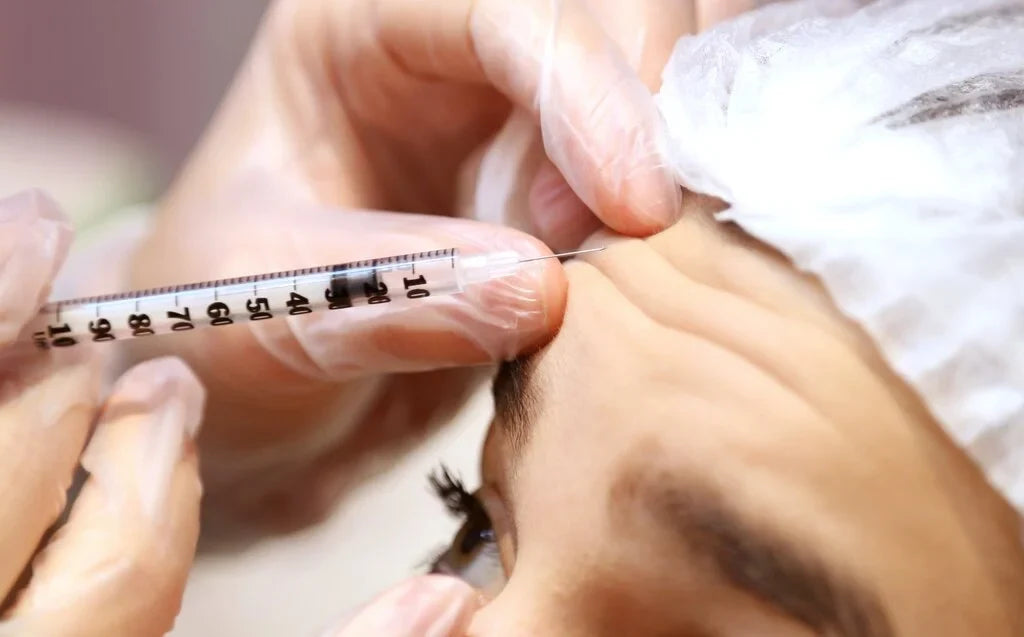If you suffer from chronic migraine, you know that the pain and symptoms can be debilitating. While various treatments are available, including medications and lifestyle changes, they don't always work for everyone.
One example is Botox injections. In 2010, the FDA approved Botox injections as a treatment for chronic migraine, and since then, many patients have used it and some swear by it. But what does the scientific evidence look like, and is it safe? This article will help you decide whether to consider using botox for migraine.
What is Botox?
Botox is the brand name for botulinum toxin or OnabotulinumtoxinA. It’s a protein derived from the Clostridium botulinum bacteria. Also known as botulinum toxin, it works by blocking the release of neurotransmitters (acetylcholine, specifically) that transmit pain signals from the nerves to the brain.
By blocking the release of acetylcholine, Botox can help to reduce the activity of the nerves around the head and neck and prevent the release of pain signals, thereby reducing the frequency and severity of migraine attacks.
In addition to its effects on pain transmission, Botox may also have a muscle-relaxing effect that can help to relieve tension headaches, which are often associated with migraine.
Can Botox Really Help Treat Migraine?
Exactly how Botox works as a migraine treatment is still being researched. However, clinical studies have shown that Botox injections can be an effective treatment option for some people. We’ll make things easier for you by summarizing several of them here.
Reduced Headache Days
One study found that Botox treatment can significantly reduce the number of headache days by up to 9 days per month. In it, 31 migraine patients received Botox injections for chronic migraine headache over a 6-month period.
Researchers learned that the Botox treatment was well-tolerated and significantly reduced headache days and pain intensity. This suggests that Botox could be an effective treatment option for people with chronic migraine.
Another chronic migraine study found that patients who received Botox had a greater reduction in headache days when compared to the placebo. The study lasted 56 weeks and involved over 1,300 adults. Researchers concluded that Botox injections reduced headache-related disability and improved overall health-related quality of life.
A long-term efficacy study looked at the effectiveness and safety of Botox for migraine over time. They found that Botox was effective in reducing headache days, and also noted a good safety profile. Only one patient out of over 700 reported a serious adverse reaction to the injections (a rash).
In 2010, a meta-analysis of multiple studies on the effectiveness of Botox for both migraine and tension headaches found that Botox was better than a placebo at reducing headache frequency and was generally well-tolerated.
Another systematic review conducted in 2022 determined that Botox injections could provide an affordable treatment option for chronic, episodic, vestibular, and unilateral migraine. The review concluded that Botox could reduce both the number of migraine attacks and the pain associated with them.
What Does the Treatment Process Look Like With Botox for Migraine?
The treatment process for Botox injections for migraine involves receiving multiple injections from a healthcare professional. A treatment takes around 15 minutes, with shots usually given at injection sites including the forehead, temples, neck, and shoulders. Treatments are administered regularly, about every 12 weeks. It may take up to 2 weeks to see the full effects of the treatment.
Risks and Side Effects of Using Botox for Migraine
Just like any other medical treatment, using Botox for migraine comes with risks and potential side effects. While Botox is generally considered safe when administered by a qualified healthcare professional, such as a headache specialist, there are some things to keep in mind.
Common Side Effects
Common side effects of Botox injections include pain or discomfort at the injection sites, potential bruising, redness, and swelling. These side effects are usually mild and subside within a few days.
Less Common Side Effects
Less common side effects associated with Botox include difficulty swallowing, muscle weakness, and drooping eyelids or eyebrows. These side effects usually arise when the injection is made in the wrong location. In rare cases, these effects can be severe and require medical attention.
Allergic Reaction
Allergic reaction to Botox is rare, but possible. Signs of allergic reaction may include rash, itching, dizziness, difficulty breathing, or swelling. If you experience any of these symptoms after receiving Botox injections, seek immediate medical attention
It is important to note that Botox injections for migraine should only be administered by a qualified healthcare professional with the right training. You should also talk to your doctor or headache specialist about any medications you might be taking. Certain drugs can increase the risk of side effects or interact with Botox.
The Rare Side Effect of Botulism
In rare cases, Botox injections for migraine can cause botulism — a potentially life-threatening illness caused by the bacterium itself. Symptoms of botulism may include difficulty speaking or swallowing, muscle weakness, blurred vision, and respiratory failure. While this complication is extremely rare, you should be aware of the signs and seek medical attention immediately if they occur.
FAQ
How long do Botox injections last for migraine?
The effects of Botox injections for migraine can last up to 3 months.
Where do they inject Botox for migraine?
Botox injections for migraine are typically administered in the forehead, temples, neck, and shoulders.
How does Botox help with migraine?
Botox helps to block pain signals by preventing the release of a neurotransmitter called acetylcholine.
What is the downside of using Botox for migraine?
Some may experience mild side effects such as neck pain or stiffness, headache, or muscle weakness in the injection area. More serious side effects are rare.
What is the success rate of Botox for migraine?
Botox has been shown effective in reducing the number of headache days per month, with up to a 9-day reduction.
Is Botox worth it for migraine?
Consult with your healthcare provider or headache specialist to make a decision based on your symptoms and medical history.
Does Botox for migraine change your appearance?
Botox injections for migraine are typically given in areas that are not visible, so there should be no noticeable changes in appearance.
Does Botox for migraine work immediately?
It can take up to 2 weeks to see the full effects of Botox treatment for migraine.
Conclusion
While Botox injections for migraine can be an effective treatment option for some, you should be aware of the potential risks. Talk to your healthcare provider about whether Botox is a suitable treatment option for you, and follow all post-treatment instructions.
Since the majority of migraineurs are also light sensitive, it’s important to manage the impact of light on your daily life. However, not all light is created equal.
Avulux® Lenses for Light Sensitivity and Migraine help you manage the impact of light on your life by filtering up to 97% of the harmful types of light and letting over 70% of the soothing light through. They are available in Axon Optics eyewear. Combine them with a healthy lifestyle, and you may find they help you live with migraine.





